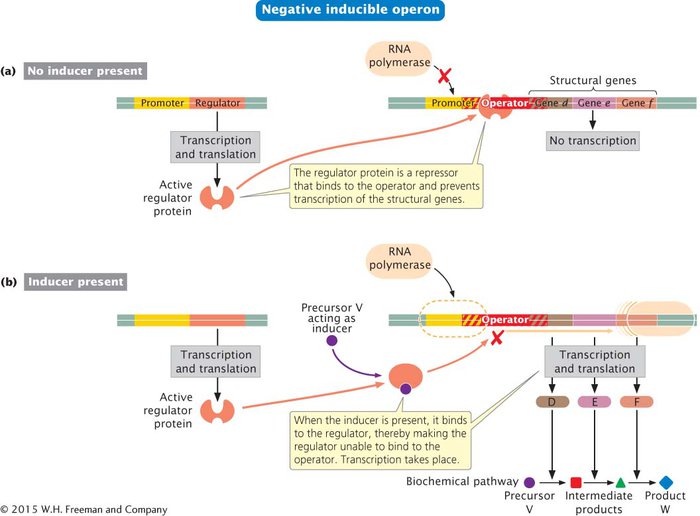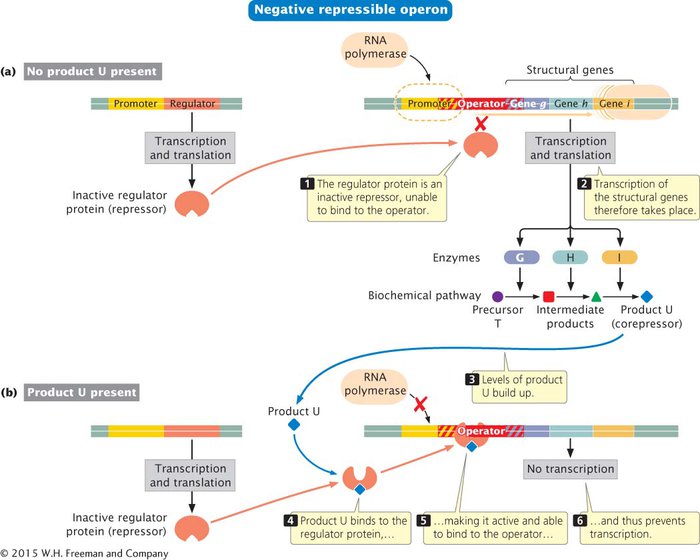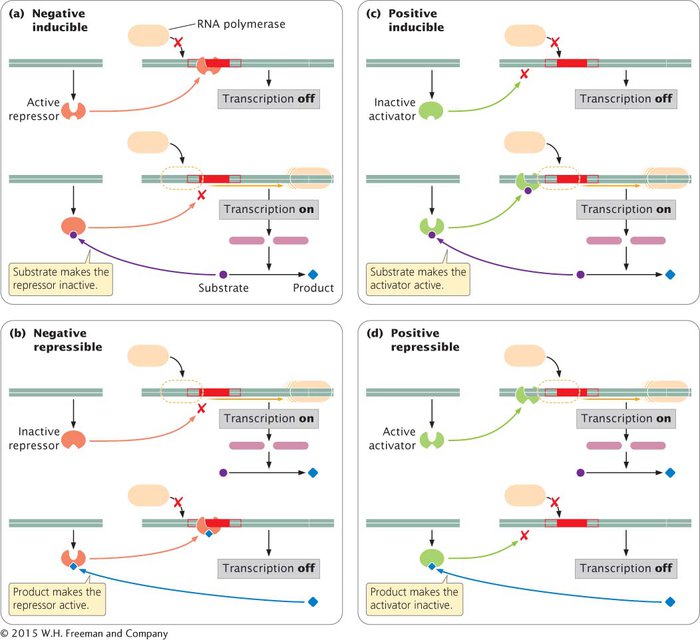Negative and Positive Control: Inducible and Repressible Operons
There are two types of transcriptional control: negative control, in which a regulatory protein is a repressor, binding to DNA and inhibiting transcription; and positive control, in which a regulatory protein is an activator, stimulating transcription. Operons can also be either inducible or repressible. Inducible operons are those in which transcription is normally off (not taking place); something must happen to induce transcription, or turn it on. Repressible operons are those in which transcription is normally on (taking place); something must happen to repress transcription, or turn it off. In the next sections, we will consider several varieties of these basic control mechanisms.
NEGATIVE INDUCIBLE OPERONS The regulator gene for a negative inducible operon encodes an active repressor protein that readily binds to the operator (Figure 12.3a). Because the operator overlaps the promoter, the binding of this protein to the operator physically blocks the binding of RNA polymerase to the promoter and prevents transcription. For transcription to take place, something must happen to prevent the binding of the repressor at the operator. This type of system is said to be inducible because transcription is normally off (inhibited) and must be turned on (induced).
Transcription is turned on when a small molecule called an inducer binds to the repressor (Figure 12.3b). Regulatory proteins frequently have two binding sites: one that binds to DNA and another that binds to a small molecule such as an inducer. The binding of the inducer (precursor V in Figure 12.3b) alters the shape of the repressor, preventing it from binding to DNA. Proteins of this type, which change shape upon binding to another molecule, are called allosteric proteins.

When the inducer is absent, the repressor binds to the operator, the structural genes are not transcribed, and enzymes D, E, and F (which metabolize precursor V) are not synthesized (see Figure 12.3a). This mechanism is an adaptive one: because no precursor V is available, synthesis of the enzymes would be wasteful because they would have no substrate to metabolize. As soon as precursor V becomes available, some of it binds to the repressor, rendering the repressor inactive and unable to bind to the operator. RNA polymerase can now bind to the promoter and transcribe the structural genes. The resulting mRNA is then translated into enzymes D, E, and F, which convert substrate V into product W (see Figure 12.3b). So, an operon with negative inducible control regulates the synthesis of the enzymes economically: the enzymes are synthesized only when their substrate (V) is available.
Inducible operons usually control proteins that carry out degradative processes—
NEGATIVE REPRESSIBLE OPERONS Some operons with negative control are repressible, meaning that transcription normally takes place and must be turned off, or repressed. The regulator protein that acts on this type of operon is also a repressor, but it is synthesized in an inactive form that cannot by itself bind to the operator. Because no repressor is bound to the operator, RNA polymerase readily binds to the promoter and transcription of the structural genes takes place (Figure 12.4a).
To turn transcription off, something must happen to make the repressor active. A small molecule called a corepressor binds to the repressor and makes it capable of binding to the operator. In the example illustrated (see Figure 12.4a), the product (U) of the metabolic reaction controlled by the operon is the corepressor. As long as the level of product U is high, it is available to bind to the repressor and activate it, preventing transcription (Figure 12.4b). With the operon repressed, enzymes G, H, and I are not synthesized, and no more product U is produced from precursor T. However, when all of product U is used up, the repressor is no longer activated by product U and cannot bind to the operator. The inactivation of the repressor allows the transcription of the structural genes and the synthesis of enzymes G, H, and I, resulting in the conversion of precursor T into product U. Like inducible operons, repressible operons are economical: the proteins they encode are synthesized only as needed.

Repressible operons usually control enzymes that carry out the biosynthesis of molecules needed in the cell, such as amino acids. For these types of operons, repressible control makes sense because the product produced by the enzymes is always needed by the cell. Thus, these operons are normally turned on and are turned off only when there are adequate amounts of the product already present.
Note that both the inducible and the repressible operons that we have considered are forms of negative control, in which the regulator protein is a repressor. We will now consider positive control, in which a regulator protein stimulates transcription.
POSITIVE CONTROL With positive control, a regulatory protein is an activator: it binds to DNA (usually at a site other than the operator) and stimulates transcription. In the lac operon, for example, an activator protein binds to the promoter and increases the efficiency with which RNA polymerase binds to the promoter and transcribes the structural genes, as we’ll see below. Positive control can be inducible or repressible.
In a positive inducible operon, transcription is normally turned off because the regulatory protein (an activator) is produced in an inactive form. Transcription takes place when an inducer becomes attached to and activates the regulatory protein. Logically, the inducer should be the precursor of the reaction controlled by the operon so that the necessary enzymes will be synthesized only when the substrate for their reaction is present.
A positive operon can also be repressible, in which case the regulatory protein is produced in a form that readily binds to DNA, meaning that transcription normally takes place and has to be repressed. In this case, the regulatory protein is produced in a form that readily binds to DNA and stimulates transcription. Transcription is inhibited when a substance becomes attached to the activator and renders it unable to bind to the DNA, so that transcription is no longer stimulated. Here, the product of the reaction controlled by the operon should logically be the repressing substance because prevention of the transcription of genes that allow the synthesis of that product when plenty of that product is already available would be economical for the cell. The characteristics of positive and negative control in inducible and repressible operons are summarized in Figure 12.5.  TRY PROBLEM 17
TRY PROBLEM 17

CONCEPTS
There are two basic types of transcriptional control: negative and positive. In negative control, a regulator protein is a repressor; when it binds to DNA, transcription is inhibited. In positive control, a regulatory protein is an activator; when it binds to DNA, transcription is stimulated. Some operons are inducible: their transcription is normally off and must be turned on. Other operons are repressible: their transcription is normally on and must be turned off.
 CONCEPT CHECK 4
CONCEPT CHECK 4
In a negative repressible operon, the regulator protein is synthesized as
an active activator.
an inactive activator.
an active repressor.
an inactive repressor.
d